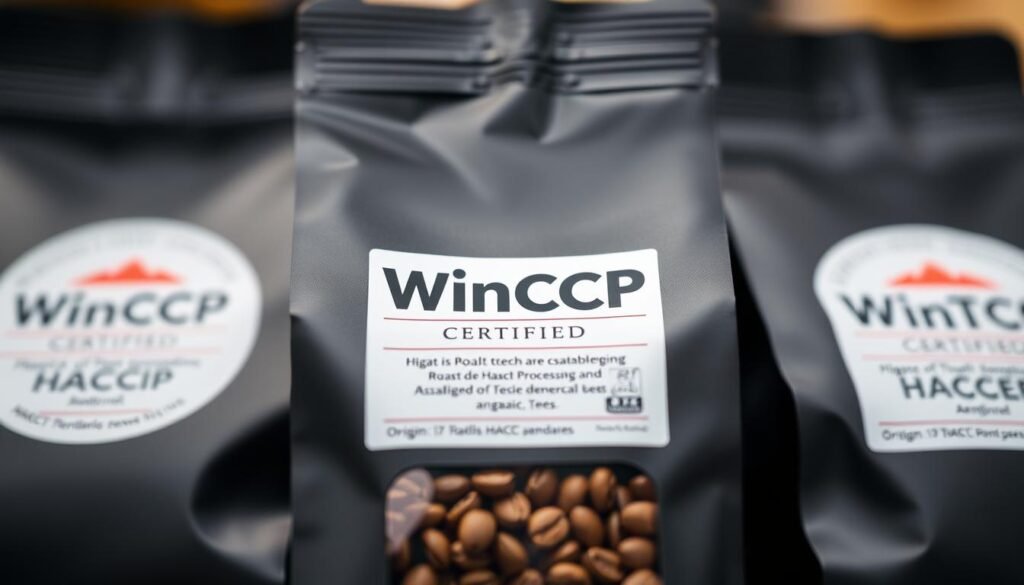Are you confident that your coffee beans remain safe and pristine from roasting to your morning brew? The Wintech packaging of coffee beans represents a critical frontier in maintaining quality and preventing potential contamination.
When it comes to specialty coffee packaging, Wintech Package understands that protecting coffee beans requires more than just an attractive bag. The packaging of coffee beans demands rigorous adherence to Hazard Analysis Critical Control Point (HACCP) principles, ensuring every step of coffee storage solutions meets stringent food safety standards.
U.S. coffee companies recognize that effective packaging of coffee beans isn’t just about preservation—it’s about guaranteeing consumer safety. From roasting facilities to retail shelves, specialty coffee packaging must navigate complex food safety challenges while maintaining the beans’ delicate flavor profiles.
Key Takeaways
- HACCP principles are crucial for safe coffee bean packaging
- Proper packaging prevents contamination and preserves quality
- Food safety standards directly impact consumer health
- Specialty coffee packaging requires meticulous attention to detail
- Coffee storage solutions must balance protection and preservation
Importance of HACCP in the Packaging of Coffee Beans
Coffee packaging is a critical process that directly impacts the quality and safety of your favorite brew. The Hazard Analysis Critical Control Point (HACCP) system plays a crucial role in ensuring the highest standards of coffee production and packaging.

Understanding the complexities of coffee freshness preservation requires a comprehensive approach to risk management. The packaging of coffee beans involves multiple critical steps that protect the product from potential contamination and quality degradation.
Core HACCP Principles in Coffee Packaging
Effective coffee packaging relies on several key HACCP principles:
- Identifying potential biological, chemical, and physical hazards
- Establishing critical control points in the packaging process
- Setting precise monitoring procedures
- Implementing corrective actions
Risk Assessment Strategies
When considering the packaging of coffee beans, manufacturers must evaluate specific risks that could compromise product quality. Vacuum sealed coffee bags offer an exceptional solution for mitigating these potential hazards.
| Risk Category | Potential Impact | Mitigation Strategy |
|---|---|---|
| Moisture Exposure | Flavor Degradation | Multi-layer Barrier Packaging |
| Oxygen Interaction | Oxidation | Vacuum Sealing Technology |
| Temperature Fluctuations | Aroma Loss | Protective Packaging Materials |
Ensuring Food Safety Standards
The United States Food and Drug Administration (FDA) mandates rigorous safety protocols for coffee packaging. By implementing HACCP principles, manufacturers can guarantee that your coffee remains fresh, safe, and of exceptional quality from production to consumption.
Choosing the right packaging approach is not just about preservation—it’s about delivering an extraordinary coffee experience that meets the highest industry standards.
Best Practices for the Packaging of Coffee Beans
Selecting the right packaging of coffee beans is crucial for maintaining quality, preserving flavor, and ensuring customer satisfaction. The packaging process involves multiple critical considerations that can significantly impact the final product’s taste and longevity.

Coffee packaging is more than just a protective barrier. It’s a sophisticated process that requires careful attention to detail and innovative solutions to preserve the delicate characteristics of whole bean packaging.
Strategic Material Selection for Coffee Packaging
When choosing coffee bag materials, you’ll want to consider several key factors:
- Barrier protection against moisture and oxygen
- Durability of packaging materials
- Compatibility with different coffee bean varieties
- Cost-effectiveness of packaging solutions
“The right packaging can preserve coffee’s complex flavor profile for months after roasting.”
Environmental Considerations in Coffee Packaging
Sustainable coffee packaging has become increasingly important for environmentally conscious consumers. Modern coffee producers are exploring eco-friendly alternatives that reduce environmental impact without compromising product quality.
Key elements of sustainable coffee packaging include:
- Biodegradable bag materials
- Recyclable packaging options
- Reduced plastic usage
- Minimalist design approaches
Coffee degassing valves play a critical role in whole bean packaging. These specialized one-way valves allow carbon dioxide to escape while preventing oxygen from entering the package, which helps maintain the coffee’s freshness and prevents bag inflation.
Your packaging strategy should balance protection, sustainability, and cost-effectiveness. By carefully selecting appropriate coffee bag materials and implementing innovative packaging techniques, you can ensure your coffee reaches consumers in optimal condition.
Monitoring and Maintenance in the Packaging of Coffee Beans
Effective monitoring and maintenance are critical components of successful packaging of coffee beans. Your facility’s commitment to quality control ensures that every batch meets the highest food safety standards. Regular checks and comprehensive training programs form the backbone of a robust HACCP system that protects both product integrity and consumer health.
Implementing rigorous compliance checks helps you identify potential risks in the packaging of coffee beans before they become serious issues. Specialized equipment and trained personnel work together to detect any deviations from established quality protocols. Airtight coffee containers play a crucial role in maintaining product freshness and preventing contamination throughout the storage and distribution process.
Regular Compliance Checks
Your quality control team should conduct systematic inspections at every stage of the packaging process. This includes monitoring temperature controls, verifying seal integrity, and ensuring that all packaging materials meet strict food safety requirements. Documentation of these checks creates a transparent record that demonstrates your commitment to excellence in coffee bean packaging.
Employee Training in Quality Assurance
Comprehensive training programs are essential for maintaining high standards in coffee bean packaging. Your employees need to understand proper handling techniques, sanitation procedures, and quality control measures. By investing in continuous education, you empower your team to identify and address potential issues quickly and effectively, ultimately protecting your brand’s reputation and ensuring customer satisfaction.